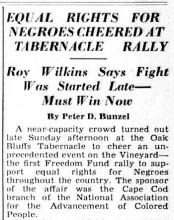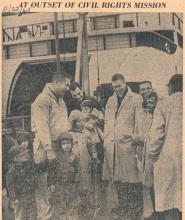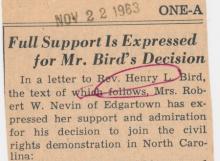U.S. Rep. John Lewis of Georgia visits Martha’s Vineyard on Friday, August 28 to celebrate the 35th anniversary of the historic March on Washington and to introduce Walking With the Wind: A Memoir of the Movement. One of the “Big Six” leaders of the civil rights movement, John Lewis is the only major speaker at the 1963 March on Washington still living.
In his autobiography, Walking With the Wind, Mr. Lewis tells the story of his journey from a childhood spent preaching to chickens and picking cotton on his family’s tenant farm to his emergence as one of the most important figures in the American civil rights movement and, later, the highest ranking African-American member of the U.S. House of Representatives. Walking With the Wind has been nominated for a Pulitzer Prize. Last month, it burst onto the Los Angeles Times’ bestseller list at number five.
“In this powerful memoir, Lewis provides a compelling account” of the civil rights movement that “evokes, with simplicity and passion, how the 1960s transformed the United States,” according to The New York Times Book Review.
Mr. Lewis will sign books at Bickerton & Ripley Books on Main street in Edgartown from 11:30 a.m. until 1 p.m. He will be the keynote speaker at a program celebrating the 35th anniversary of the March on Washington at Union Chapel on Circuit avenue in Oak Bluffs. The program is from 2 to 3:30 p.m. Joining him on the program will be nine-year-old Sebastian Corwin, a student at West Tisbury Elementary School, and Vineyard Haven resident Marianne Larned, author of Life Changing Stories of Kindness & Courageous Acts of Service.
Following the program, on the lawn of the chapel, there will be a reception in Mr. Lewis’s honor and a book signing. Sponsored by the Martha’s Vineyard Chamber of Commerce and Harvard University, the program, the reception and book signing are open to the public. The host committee for the event includes Henry Louis Gates Jr., A. Leon Higginbotham Jr., Anita Hill, Cornel West, Charles Ogletree and Anna Deveare Smith.
Journalists are invited to request interviews with Mr. Lewis both prior to and during his visit. He is available to discuss not only his life, but where we stand today on race relations and where we should go from here.
During the height of the Civil Rights Movement from 1963 to 1966, Mr. Lewis was the chairman of the Student Nonviolent Coordinating Committee. SNCC was largely responsible for the sit-ins and other activities of students in the struggle for civil rights.
Despite his youth, Mr. Lewis became a recognized leader in the Civil Rights Movement. He was one of the “Big Six” leaders of the Civil Rights Movement. (The other Big Six leaders were Whitney Young, A. Phillip Randolph, Martin Luther King Jr., James Farmer and Roy Wilkins.) Mr. Lewis was one of the planners and a keynote speaker at the 1963 March on Washington.
In 1964, Mr. Lewis coordinated SNCC efforts to organize voter registration drives and community action programs during the Mississippi Freedom Summer. The following year, Mr. Lewis led the demonstrators in Selma, Ala., in one of the most dramatic nonviolent protests of the movement, Bloody Sunday. It was Bloody Sunday that led to the passage of the Voting Rights Act.
Despite 40 arrests, physical attacks and serious injuries, Mr. Lewis remained a devoted advocate of the philosophy of nonviolence. Mr. Lewis’s career would eventually take him to the halls of Congress, where he now serves as Chief Deputy Democratic Whip in the House of Representatives.









Comments